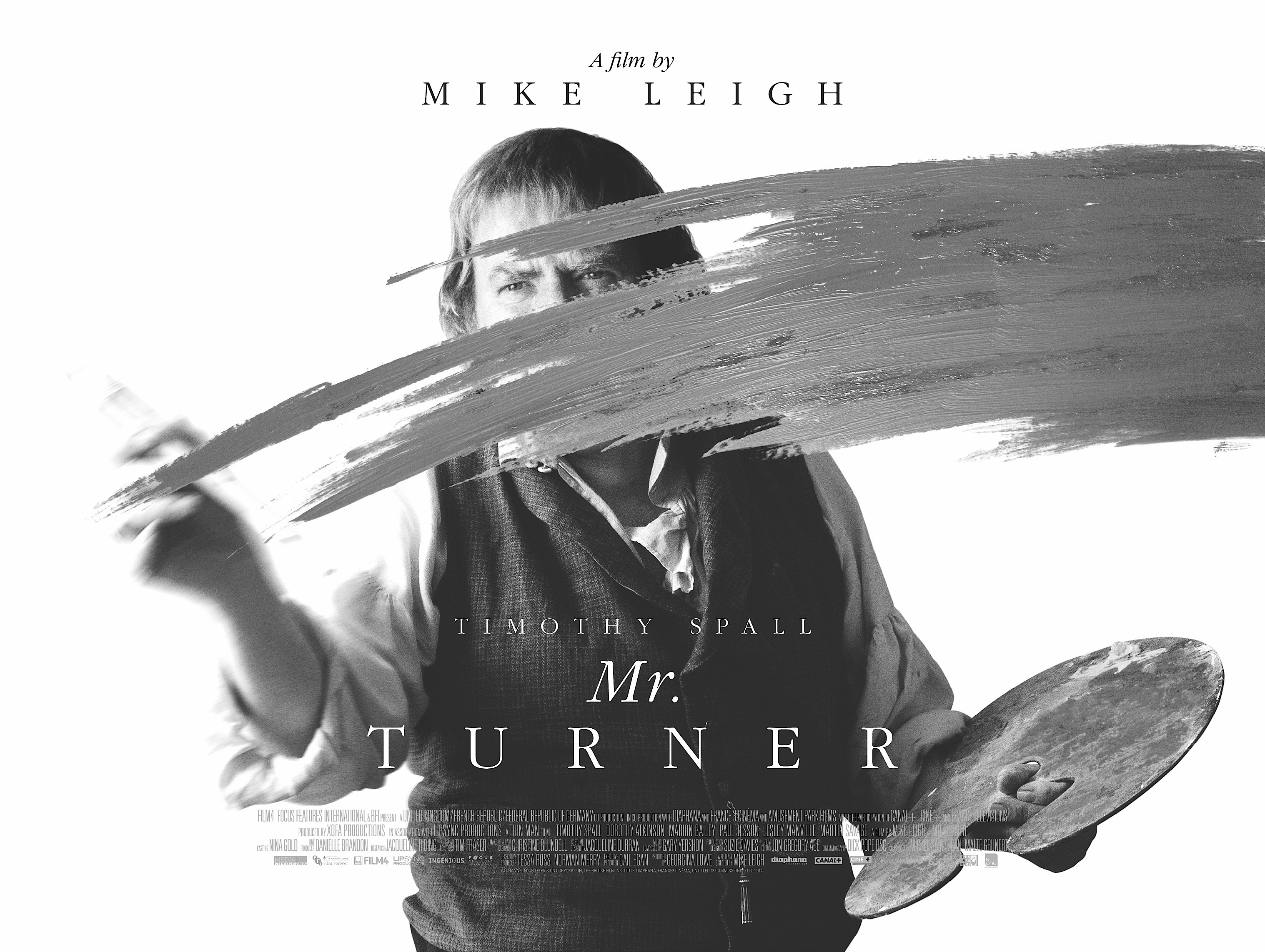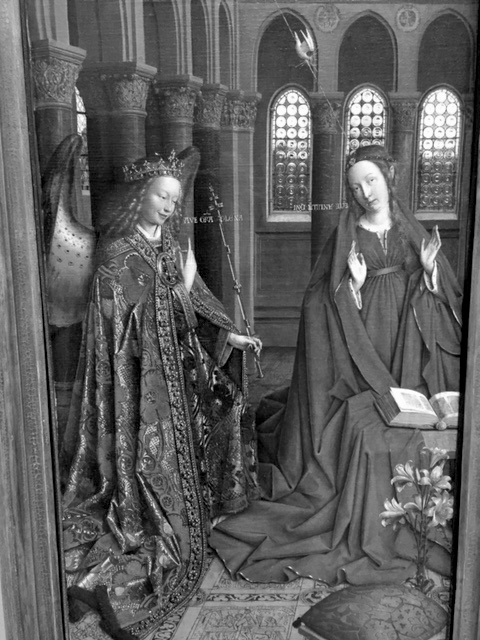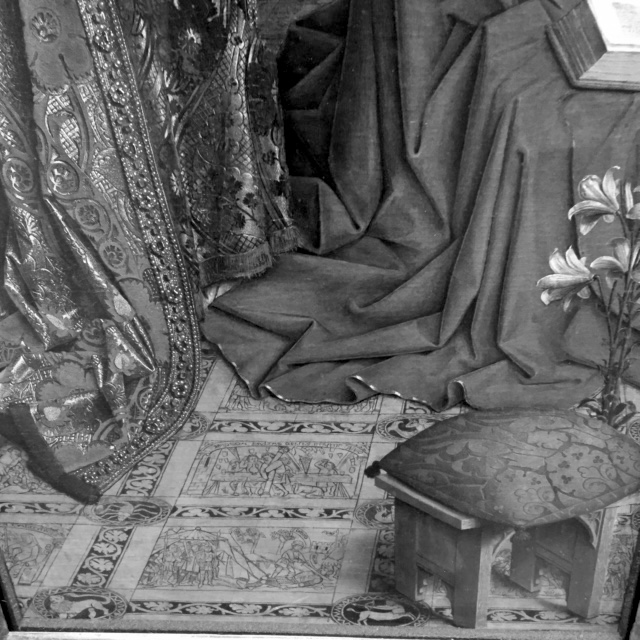J. M. W. Turner on film and Jan van Eyck in The Smithsonian Institution
By Bernie Langs

Lord Kenneth Clark, the eminent late art historian who often graces the pages of “Culture Corner”, felt that life’s meaning can best be found through the study of paintings, which later bled into his world historical view of “civilization” that encompassed architecture, sculpture and even the theories of how economics shape cultures and move the masses. In the past, I have read as much of Clark’s works as I could and I now recall his discussion of how certain artists cannot be easily categorized, so unique are their works. He boiled it down to cases of an almost divinely-touched sense of an individual physical vision. Joseph Mallord William (J.M.W.) Turner was one such painter discussed by Clark. Turner’s ability to “see” and then paint with accuracy or imagination (or both) the sea, its foam and waves, the detailed bubbling of turbulent waters hitting hard wooden ships, the shapes and phantoms rising from terrific storms, remains unequaled to this day.
In the film “Mr. Turner”, written and directed by Mike Leigh, the life of J.M.W. Turner (1775-1851) is presented with all the harshness of his times along with a contrasting and almost Dutch-like pristineness. Details, for example, of particular drawing rooms with their cinematographically well-lit furniture, basins or candlesticks, and striking or muted colors make “Mr. Turner” a wonder of a movie. Timothy Spall plays Turner in a marvelously strange and complex manner, often difficult to watch, as he grunts and barks with a near-Cockney biting, graveled voice. By contrast, Spall played a conniving Rosencrantz to Kenneth Branagh’s vengeful Hamlet smoothly, and his take on Turner seems to combine his roles as the rat-like villain Peter Pettigrew (“Wormtail”) in the Harry Potter films with his amusing characterization of Winston Churchill in “The King’s Speech.”

The roughshod Mr. Turner makes his sketches as often as he can, but it only seems obsessive at the end of the film, when he is compelled to leap from his deathbed to run outside in his bedclothes to draw “from life” a woman’s dead body washed up on the shore near his seaside home. I kept trying to reconcile the idea of Clark’s notion of a visionary with the hard-as-nails reality that Mr. Leigh bludgeons us with throughout this movie. But don’t misunderstand me, the movie is fantastic and the genius of Turner’s inner world is there for the taking if you look for it. The key scene, where Lord Clark’s Turner is on display, is when during a stormy sea voyage, Turner insists on being tied high on the ship’s mast, like a latter day Ulysses, in order to see the raging waters about him to gain a first-hand knowledge and vision of nature’s mighty torrent. The nitty-gritty Turner meets the soulful artist in that moment and Spall plays it masterfully.
Shifting gears to Renaissance paintings, Erwin Panofsky, as did other art historians, seized on the idea of understanding Renaissance artists in the context of their times as a means of unlocking their secrets. I believe that there comes a time when the educated art viewer must put it all aside and simply look. By looking carefully, all the theories and postulations of the great historians retreat to a near unconscious level and the charge of finding meaning is left to oneself as they guide us in inaudible whispering.
When I stood in front of the magical painting by Jan van Eyck in the National Gallery of Art in Washington, DC, I was overwhelmed to the point of a being severely lightheaded and feared for a moment that I might faint right there in the almost empty gallery. Van Eyck painted the Virgin in a church setting, being told by the Archangel that she will bear the Christ through Immaculate Conception. I can’t exactly remember the pages I read by Friedlander and Panofsky about this individual masterpiece, but the training on looking at the details came back to me immediately. Van Eyck is well known for having developed new oil-based paints for panel painting that gave pictures a deeper rainbow of bold coloring, many of which have held up well over the centuries. I would also say that Van Eyck and his school also acted as the world’s opticians, the way that a television viewer can compare the blurred picture on early television sets to the terrific sharp images of high definition ones. Van Eyck focused the world’s microscope. He was able to sharpen how we see the world. It’s like the moment you put on corrective glasses for the first time and the doctor says, “How’s this, better?” Much better! And it’s a most pleasant shock of clarity.
Van Eyck’s message for me, that day at The Smithsonian, was not directly spiritual, but through this medium of his encompassing religion, I detected a faith in an all-seeing eye, the notion that with visual mastery, something is revealed. The presenting angel, for example, is a hallucination, it shouldn’t be there, and it shouldn’t exist even in the 15th century imagination. It’s a “good” angel yet it is disturbing in its hyper-reality, not shared by Mary standing right next to him, but somehow, in a different realm of the space continuum, which, of course, is our reality.
 The imagined church setting makes the angel’s presence even more troubling. As I looked harder, deeper into the pictorial space, the angel’s robe seemed to flow out from the two-dimensional surface and the embroidery and jewels appeared to be impossibly rendered in its exacting detail. How could anyone see such detail and walk around with it on a daily basis? I felt that van Eyck’s ultimate mission was not to present God as a voice to Mary about her/The Son, but as a message to all who would see his work that “this is the miraculous sharp-tuned world I know, please take from it what you will.” Van Eyck’s painting goes beyond pure representation, sails past a Platonic and possibly absurd “form”, and is beyond a Buddhist-like, or philosophical empty abstraction. My bottom line was: I have no idea how to really capture what I saw and thought, but the depth of its power was exciting, I learned from it.
The imagined church setting makes the angel’s presence even more troubling. As I looked harder, deeper into the pictorial space, the angel’s robe seemed to flow out from the two-dimensional surface and the embroidery and jewels appeared to be impossibly rendered in its exacting detail. How could anyone see such detail and walk around with it on a daily basis? I felt that van Eyck’s ultimate mission was not to present God as a voice to Mary about her/The Son, but as a message to all who would see his work that “this is the miraculous sharp-tuned world I know, please take from it what you will.” Van Eyck’s painting goes beyond pure representation, sails past a Platonic and possibly absurd “form”, and is beyond a Buddhist-like, or philosophical empty abstraction. My bottom line was: I have no idea how to really capture what I saw and thought, but the depth of its power was exciting, I learned from it.
I walked out of van Eyck’s Smithsonian room believing I’d never really need to see another painting again, that this was some kind of absolute pinnacle in my quest to see great art.
